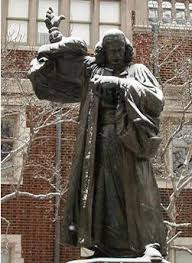Last week, the University of Pennsylvania announced plans to remove its statue of George Whitefield, a famous eighteenth-century British preacher, due to his condoning slavery. What was the statue, made by R. Tait McKenzie in 1919, doing at Penn? Whitefield was a lifelong friend of Benjamin Franklin, the founder of the university. Moreover, as the Penn website notes: “Franklin chose the Whitefield meeting house, with its Charity School, to be purchased as the site of the newly formed Academy of Philadelphia which opened in 1751, followed in 1755 with the College of Philadelphia, both the predecessors of the University of Pennsylvania.” Apparently Franklin, who published several of the preacher’s texts, was more tolerant than his successors. But the mob has its own reasons, or in this case putative reasons, for Penn’s action appears to have been preventative. Whitefield had to go. But what’s next? Architecture often assumes a commemorative function, must it, too, be cancelled in this misbegotten attempt to rewrite history? If Jefferson and Washington are suspect, what about their homes, Monticello and Mount Vernon. To make matters worse, the houses were built with slave labor. The architecture of both was influenced by the prevailing eighteenth-century fashion for Classicism, a style that originated in ancient Rome and Greece. Both were slave-owning societies, so no doubt temple pediments and Ionic columns will sooner or later be called into question, too.



The problem I have with any complaints about “re-wrting history” is embedded in the words themselves. History is be definition a radical distillation of what occeured. All the messy facts of reality are condensed down to tell a coherent story. What is left out is hopefully irrelevant, but may also simply be embarrassing, or simpler counter to the narrative.
Hopefully we are all beginning to understand that slavery, institutional racism and their related violence, up to and often including murder, are not irrelevant to us today, but central to our actual history. Acknowledging that reality, and seriously examining the sometimes clay feet of the central characters in our history, is not re-writing history, it is simply considering it more fully than was done in the earlier narratives.
I’m sure there are many who think they are somehow “losing something” in this expanded narrative. Maybe so. Since History has always been the active process of leaving out, something was always lost. All too often, that loss was an important component of the truth.
A thoughtful comment, although I notice it ends with that loaded word, “truth.” Hilary Mantel wrote that “History is not the past, it is the method we have evolved of organizing our ignorance of the past.” I agree with that.
I can’t help adding that slavery and institutional racism are NOT central to MY past. My parents and ancestors were middle-class Poles, and while one is likely to find anti-semitism, slavery was not part of their heritage. Go back far enough and you would no doubt find serfdom, the medieval equivalent of slavery. But go back far enough in any civilization, European, Asian, or African, and you will encounter slavery. And recently, too. It is hardly unique to the US.
My own family has roots as immigrants and poor, borderline impoverished tenant farmers. But as the white poor, my parents had access to higher education, federally insured home loan programs, and unquestioned access to the best public schools in their community for their children. Virtually none of which was true for black America. As with with your family, I can’t find any accounts of slave holding in our past. But to go from that absence of personal guilt, and then to say that institutional racism and it’s roots doesn’t effect who has access to what resources strikes me as naive at best, intentionally ignorant at best. It’s no coincidence that most of the statues of confederate “heroes” went up in the context of civil rights debates during the 20th century, not during the confederacy. Our history was written for a reason, let’s at least try to understand those reasons.
I should finish by noting that I am a regular and appreciative reader of your essays on architecture and design, and remain a huge fan.
Sounds like you read my novel after all. I sent you a copy of “Who Seeks to Please” a couple of years ago, at the suggestion of the late Michael McKinnell.
Sorry, doesn’t ring a bell with me.